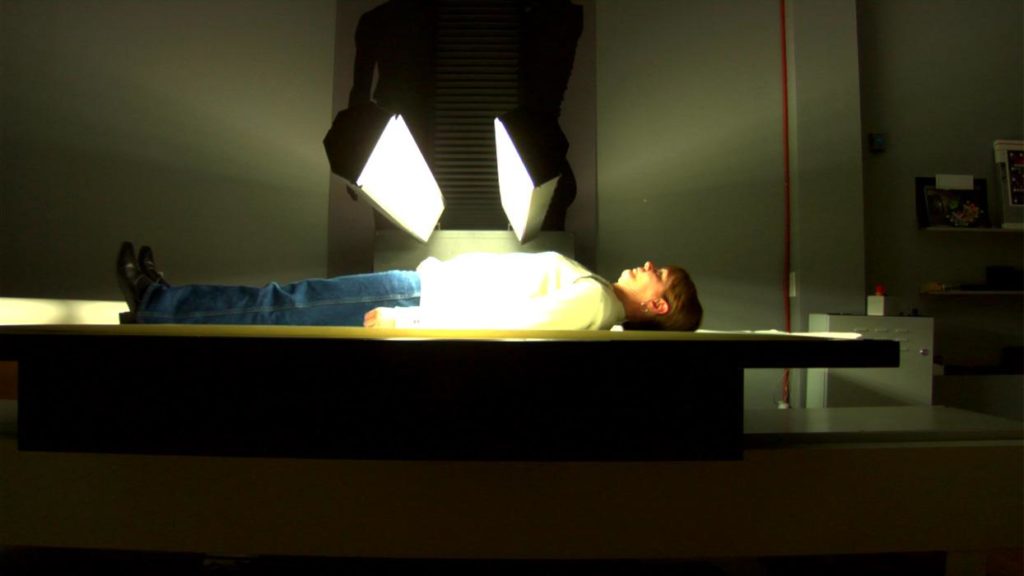Annette Mangaard’s luminous new documentary on the life and career of Suzy Lake (which will be part of the Art Gallery of Ontario’s massive Lake retrospective opening November 5) plays like a cross between a well-scripted, jam-packed A&E Biography program and a dreamy, experimental film. Lake gives fantastic quote, and watching her at work is a pure joy—she’s a gentle but tough machine. Mangaard also gets great material out of Lake’s contemporaries and admirers—Barbara Astman, Mary Beth Edelson, Lisa Steele—who speak not only of Lake’s career but of how dramatically the art world (and real world) has changed (thanks in part to people like Lake) for female-identified artists since Lake’s emergence. And also how little.
Mangaard followed Lake around for almost four years, and filmed Lake filming herself during several iterations of Lake’s new series of hour-long, very slow exposure, photographed performances. Watching Lake quietly assert her right to public space in front of various world monuments, standing still while all around her rushes past, is akin to watching a master dancer execute a flawless move. Lake may look small and delicate, but her backbone is made of iron.
Corresponding with Mangaard about her documentary, I learn that the final product cost her “blood, sweat, and money,” but one senses it was worth it. This is a film made by a fan that never sinks to fan-girl flattery or simple hurrahs. Lake is a complex artist and person, and Mangaard’s documentary is a conversation between subject and director, not a hagiography.
R.M. Vaughan: Assembling all that archival material (from the 1960s to now) and the interviews must have been a huge challenge.
Annette Mangaard: The idea began with a chat with Maia-Mari Sutnik of the AGO about five years ago (long before any exhibition with Suzy was planned). Maia spoke of Suzy’s large and interesting body of work. I researched her and did a few preliminary interviews with Suzy. I applied for and received grants … all that took about two years. Suzy is a nice, normal person who does not keep every scrap in perfect order, so it was a challenge not only to sift through the work, but, in some cases, to locate the work or the files.
Suzy and I went to London and New York together so I could film her doing the one-hour performances for her own camera. It was challenging to keep up with her because Suzy becomes totally focused on what she is doing and I have to try to film everything I can in order to have possibilities in the edit room—at times, she was just too quick for me.
The edit was another big monster—with so many seminal figures in the art world agreeing to be interviewed, how would I keep them on track and relay their message within the larger context of the film? The film is really two stories—that of Suzy and also that of all the female artists from the same era. I think that Suzy puts a very personal context to the story of that generation and their struggles—she epitomizes it with her work and her life story. It’s important for the next generation of young women to understand who knocked down the walls that were there, and to some extent still exist. The glass ceiling hasn’t gone away.
RMV: Some of the interviews with Lake are quite personal. Did you worry that you were being invasive?
AM: Oh yes! That is always a problem. Suzy is a very private person who was concerned with information about her personal life emerging, and there were several cases where I had her saying things on camera that I really wanted to use, but one absolutely must respect the wishes of subjects, and this is not an exposé. When approached to be the subject of a film, a person has no idea how invasive it will be or that it will take a very long time! I always tell people that after several years they will come to dread having me and my camera show up, and it’s usually true.
RMV: Lake is a master technician. How much time did you spend in her studio watching her make things?
AM: With this type of film, there is usually a lot of hanging around, gathering information—both visual and audio—and getting good coverage, which means lots of close-ups. I do the filming and audio recording and everything else myself (except the edit) and so it’s just me and the subject … for long periods of time. It was really magical to be in the darkroom with Suzy—who knew you could even buy developing chemicals anymore!
RMV: The film gives us Lake’s life and work from childhood to the late 1970s, and then seems to pick up the thread again in the present, or recent times. Where are the works/life stories from the 80s and 90s?
AM: It became apparent that not all of Suzy’s artistic output would fit, and so I went for the work she spoke about the most and that spoke to me. I think that Suzy, like many women, was really struggling during the middle period of her career—with time, family, money and all those other things that keep one from having the wherewithal to make art.
RMV: What’s next for you? Another documentary? Who?
AM: Yes, but I am keeping it under my hat for now. This is about a very well-known artist who does a lot of advocacy around a subject I have become consumed with—the natural world and our lack of enjoyment of, appreciation for and conservation of it.
Annette Mangaard’s documentary Suzy Lake: Playing With Time is part of the exhibition “Introducing Suzy Lake” that will be at the AGO from November 5, 2014, to March 22, 2015. The film will also have its theatrical world premiere at the gallery’s Jackman Hall on November 21.









